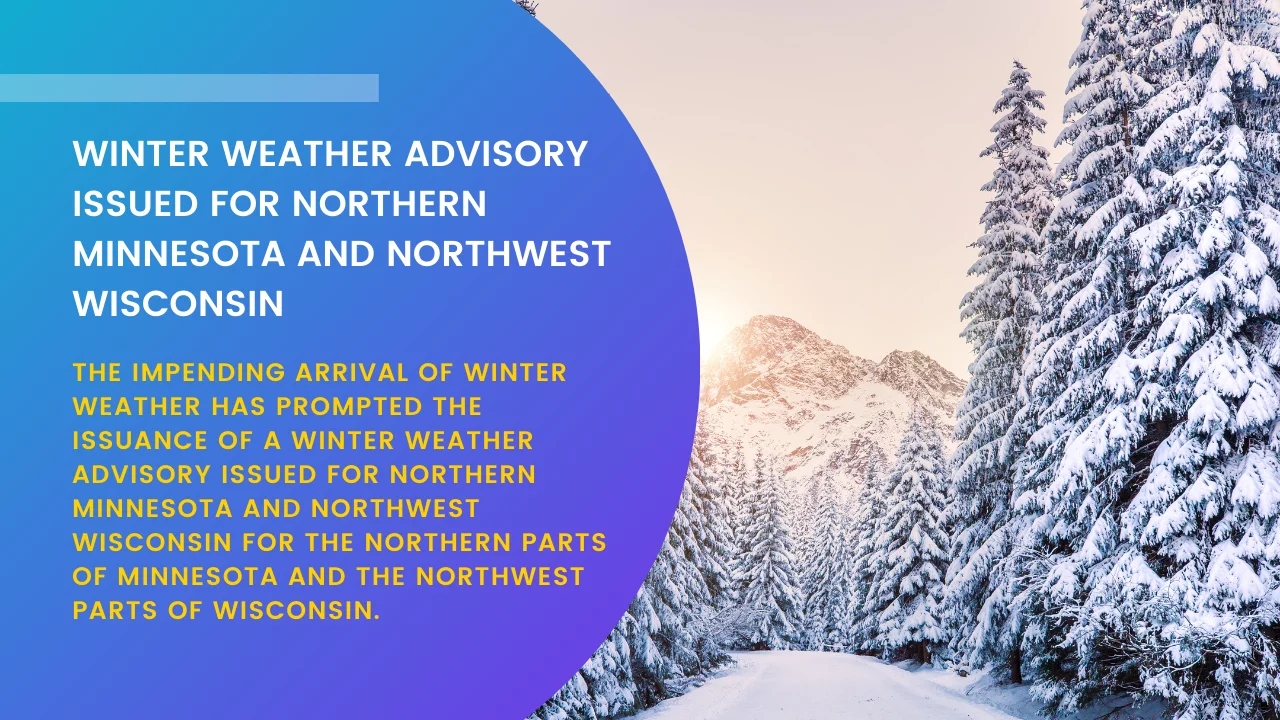The impending arrival of winter weather has prompted the issuance of a Winter Weather Advisory Issued for Northern Minnesota and Northwest Wisconsin for the northern parts of Minnesota and the northwest parts of Wisconsin. Snowfall, slick roads, and diminished visibility are all things that locals and visitors to these regions should be aware of and be prepared to deal with. The purpose of the advisory is to ensure that communities are well-informed and ready for winter by providing them with the information they need to stay safe.
Understanding the Winter Weather Advisory
When the National Weather Service (NWS) issues a Winter Weather Advisory, it’s to warn people that mild winter weather is on the horizon, which could pose serious problems for travel and other everyday activities. When snowfall is anticipated to affect local travel conditions, regardless of whether it meets the severity criteria for a Winter Storm Warning or not, residents of northern Minnesota and northwest Wisconsin will receive the advisory. Since winter weather can rapidly become dangerous if not addressed, the primary objective of the advisory is to promote readiness and vigilance among both locals and visitors.
Importance of Winter Weather Advisories
An important function of winter weather advisories is to notify communities of conditions that, although not severe enough to warrant a full storm warning, can nonetheless pose difficulties and risks. It is important for residents of northern Minnesota and northwest Wisconsin to be cautious on the roads, make necessary adjustments to their travel plans, and stay informed through reliable weather updates. These advisories serve as a call to action. The warning stresses the importance of being alert and vigilant, especially when it comes to safe travel and being ready for winter weather.
What Conditions Trigger a Winter Weather Advisory?
Depending on the specific weather conditions that could cause problems or danger, winter weather advisories are issued. Snowfall and its effects on travel are usually the main points of the advisory when it comes to northern Minnesota and northwest Wisconsin. To better understand the possible impacts and make necessary adjustments to their plans, residents should familiarize themselves with the criteria.
Snow Accumulation
A major consideration in making an advisory is the amount of snowfall. To help communities get ready for potential travel hazards, the NWS may issue an advisory when there is an expectation of a significant accumulation of snow. Even a light dusting of snow can make life more difficult in rural and less-populated parts of northern Minnesota and northwest Wisconsin, where snow removal might take longer than usual.
Reduced Visibility
When snow falls, it becomes much more difficult for drivers to see their surroundings, including other cars and pedestrians. The danger of accidents increases and travel times can be lengthened due to reduced visibility. Those on longer trips or commuting should exercise extra caution and drive cautiously during advisory periods due to visibility issues, which can cause delays.
Slippery Road Conditions
Untreated or rarely plowed roads are especially dangerous when snow and ice are present. Skidding, losing control, and collisions are more likely on surfaces with a high coefficient of friction. To reduce the likelihood of accidents on wet roads, the advisory stresses the need of slowing down, keeping a safe following distance, and being prepared to brake suddenly.
Snow-Covered Roads
Not only are snow-covered roads more difficult to navigate, but they also put more strain on vehicles. It is especially important to drive carefully and keep your vehicle well-maintained in the winter because snow-covered roads can delay both daily commutes and emergency response times for people living in northwest Wisconsin and northern Minnesota.
Impact on Public Transportation
Delays, reduced schedules, or route modifications may be in store for communities dependent on public transportation due to winter weather advisories. Commuters may become stranded if snow and ice affect public transportation. By being informed about the advisory, residents can make preparations for alternate routes or additional travel time as needed.
Preparing for a Winter Weather Advisory
It is crucial to be well-prepared in order to stay safe and minimize disruptions when a winter weather advisory is issued. Winter safety and comfort can be achieved by those living in northern Minnesota and northwest Wisconsin who are prepared and know what to expect.
Essential Travel Tips
During a winter advisory, the main concern is the safety of travel. One should take basic precautions such as not traveling unless absolutely necessary, allowing extra time for travel, and reducing speed on roads covered with snow. It is also important to inform someone of your travel plans, check road conditions, and plan routes carefully in case of hazardous conditions.
Emergency Kit for Vehicles
When getting ready for winter, make sure to have an emergency kit in your vehicle. In the event of unforeseen delays or emergencies, having essentials such as food, water, a first aid kit, a shovel, a blanket, and a light can be incredibly helpful. The message of this advisory is that drivers should always be ready to handle themselves in an emergency.
Staying Informed
For people in impacted areas, it is critical to stay informed about the most recent weather updates. For up-to-the-minute information on advisory changes and road conditions, you can rely on reputable sources such as the National Weather Service, local news channels, and weather apps. Listening to radio updates is another great way to stay informed if you don’t have regular access to the internet.
Safe Home Preparations
The advisory emphasizes traveling, but residents should also be ready for possible power outages by stocking up on heating supplies, emergency equipment, and other necessities. Before the long winter hits, it’s a good idea to stock up on necessities, check that heating systems are working, and have a backup power source (if possible).
Travel Adjustments
The advisory advises locals who are planning long-distance trips to look into alternate dates or routes if they can. Air travel is also susceptible, so it’s wise to contact airlines in advance to find out about delays or rescheduling options.
Travel Safety Tips During a Winter Weather Advisory
It takes vigilance and planning to travel safely during a winter weather advisory. Here are some specific things to keep in mind when you’re traveling through northwest Wisconsin and northern Minnesota during advisory periods.
Reduce Speed and Increase Following Distance
For your safety on roads covered in snow or ice, slow down and leave more space between cars. Because skidding can occur from abrupt acceleration and braking, drivers must exercise extreme caution.
Prepare Your Vehicle
For safe travel, winterizing vehicles is essential. To avoid typical car problems in cold weather, check the tire pressure, battery life, and wiper function regularly. For your vehicle’s safety during advisory periods, remember to add antifreeze and check the tread depth.
Avoid Distracted Driving
Keeping your eyes on the road becomes even more crucial when driving in winter conditions. All eyes must be on the road when driving due to reduced visibility, icy conditions, and other dangers. For optimal focus, it’s best to put down the phone or put them somewhere else out of earshot.
Monitor Road Conditions
Winter weather advisories can cause a dramatic shift in road conditions. In order to plan safer routes or postpone travel if necessary, drivers can stay updated on road conditions through GPS apps or local transportation websites.
Plan for Potential Delays
Traffic, accidents, and emergency vehicles can all add unnecessary delays to travel times when a winter weather advisory is in effect. When driving on snowy or icy roads, it’s best to give yourself more time to reach your destination.
FAQs
What Should I Include in My Car Emergency Kit for Winter Travel?
For winter travel, an emergency kit should include warm blankets, water, snacks, a flashlight, extra batteries, a first-aid kit, and tools like a snow shovel and ice scraper. In case of longer delays, having extra clothes, a cell phone charger, and any necessary medications is also recommended.
How Does a Winter Weather Advisory Impact Local Travel in Minnesota?
A winter weather advisory usually means that local travel may be slower and potentially hazardous. Snow-covered roads, icy patches, and reduced visibility can create challenges for drivers, often leading to accidents and travel delays. Staying informed about road conditions and planning for extra travel time can mitigate some of these issues.
How Much Snow Is Expected During a Typical Winter Weather Advisory?
The amount of snow in a winter weather advisory varies based on location and conditions. For northern Minnesota and northwest Wisconsin, advisories may indicate light to moderate snowfall that, while not severe, can still accumulate enough to create slippery roads and visibility issues.
Can Schools Close During a Winter Weather Advisory?
Yes, schools may choose to close or delay opening depending on the severity of the weather conditions. Safety for students and staff is a priority, and administrators monitor weather advisories closely to make informed decisions about closures or schedule adjustments.
What’s the Difference Between a Winter Weather Advisory and a Winter Storm Warning?
A Winter Weather Advisory indicates that snow, ice, or other winter conditions are expected to be inconvenient or mildly hazardous. In contrast, a Winter Storm Warning signifies more severe conditions, such as heavy snowfall or ice accumulation, that can pose significant threats to safety and property.
Also Read: Wallpaper:a7cypgzkm5q= White
Conclusion
Finally, the unpredictability of winter weather in northern Minnesota and northwest Wisconsin is highlighted by a Winter Weather Advisory. Winter Weather Advisory Issued for Northern Minnesota and Northwest Wisconsin, this advisory does not constitute a storm warning, but it does signal potentially dangerous weather that calls for meticulous preparation. Residents and travelers can safely navigate these conditions by staying informed, preparing their homes and vehicles, and exercising caution on the roads. As a community, we can face the winter weather head-on and make the most of the season’s special beauty if we adopt the correct attitude and get ready for it.

Karen Altizer is a seasoned professional with a wealth of expertise in marketing and communications, adept at crafting compelling narratives and strategic messages tailored to various stakeholders.

